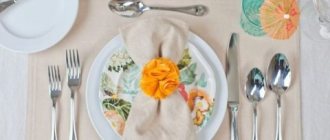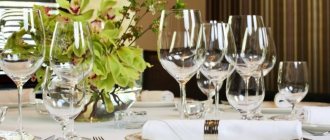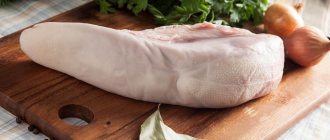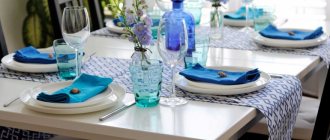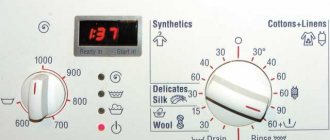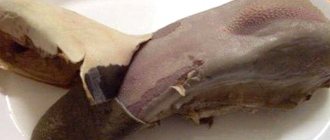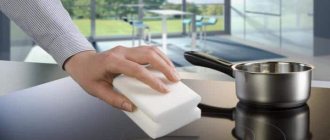There are situations in every person’s life when they need to show their best side at the table. To do this, you need to know in which hand to hold a knife and fork according to etiquette, as well as some other rules. There may be differences between cultures, but the general concepts of etiquette are the same for everyone.
General rules of behavior or table etiquette are the minimum that every cultured person should know.
Traditional cutlery
Traditional cutlery includes forks, spoons and knives. These are used to create sets whose names speak for themselves:
- snack bar - for salads, appetizers, as well as hot meat dishes;
- fish;
- dining room - in addition to a fork and knife, it includes a soup spoon;
- dessert.
The table set surpasses all others in size. A fish pair is a 3, 4 or 5-pronged fork, sometimes with a hole in the center for removing the bone, and a spatula-shaped knife. For steaks, use a special serrated or sharp knife.
It is no coincidence that the list does not include devices that are intended for laying out food from a common table: tongs, spatulas, ladles. All of them are classified as serving dishes. It is necessary to strictly distinguish between two concepts: serving utensils are common, tableware is individual.
What not to do with a knife and fork
You cannot store prepared food with cutlery. Before putting food into the refrigerator, you will have to remove forks, spoons, and knives from the plate or pan.
It is not customary to use devices for eating bread, since the crumb crumbles a lot. Pizza and burgers should also be eaten with your hands.
It is forbidden to eat from a knife. This is not only indecent, but also dangerous, since a person can easily cut his lips or tongue.
Do not leave cutlery criss-crossed on the plate. This will show the owners that you didn’t like the food or service.
Dessert table utensils
The third course is eaten using a triple set. The dessert knife is shaped like a spatula, but smaller than a fish knife. It is held in the left hand to pry small pieces and cut large pieces of fruits and berries. Cakes and pastries are eaten using a snack fork and knife. Select berries from compotes with a dessert spoon.
Dessert table utensils also include spoons for:
- coffee - with a narrow, sometimes oval, handle and a shallow cup-shaped part;
- sugar - popularly called tea.
A coffee spoon and a teaspoon lie on the right side of the saucer with a mug. When stirring drinks, avoid glass clinking.
Funeral table: forks are prohibited
Many traditions have the deepest roots and this makes them seem incomprehensible to many of our contemporaries. Why, for example, is only a spoon served at a dinner in honor of a person who has passed away? Indeed, there will be no sharp objects at the wake.
Initially, people held a funeral dinner right above the grave. Over time, this ritual was transferred to the table. Interestingly, the church does not prohibit the use of forks and knives at funerals. However, until now, only a spoon can be found on the funeral table. Where did this tradition come from? There are several reasons for this.
The funeral menu did not require a fork
The first version is quite logical. The meal consisted of three dishes: kutia, pancakes and jelly. To eat kutya, you needed a spoon. It was customary to take pancakes with your hands. And for the third, all you needed was a glass. The fork and knife were absent from the table as unnecessary.
Sharp objects could hurt the soul
The second version is rooted in paganism. At that time, it was customary to leave all piercing and cutting objects outside the room where the funeral meal was held. Esotericists later explained it this way. Sharp objects can injure a soul that is located near the table at a funeral.
Sign of "demonicism"
The third version has also reached us through millennia. In ancient times, forks were also considered demonic because they resembled the devil's trident.
Forks began to appear in Rus' during the reign of Peter I, who brought this innovation from Europe. By the way, the common people believed that the king wanted to destroy their souls, and completely rejected these devices.
To ensure that the wake is without injury
In addition, do not forget about domestic fights. The division of property could begin right at the funeral table, especially if the deceased was wealthy.
In this case, the absence of piercing and cutting objects at the table significantly reduced the likelihood of severe injuries and deaths.
As we can see, our ancestors had enough reasons to ban forks at funerals. But we don’t eat them during the funeral dinner, continuing the tradition. We do this, most likely, paying tribute to the memory of previous generations.
Special cutlery for exotic dishes
At celebrations, hosts and restaurateurs strive to surprise guests with delicious food. Oriental dishes and seafood deserve special attention. For exotic delicacies, etiquette rules provide no less fancy tools:
- Chopsticks - used when serving oriental dishes: sushi, rolls, etc. One chopstick with its thick part is placed in the hollow between the thumb and index finger of the right hand so that the device protrudes a third beyond the palm. Approximately in the middle, the stick should come into contact with the nail phalanx of the ring finger. The second part of the eastern fork is taken like a pencil, held with the thumb, index and middle fingers. How to hold while eating: the upper part is manipulated, while the lower part remains motionless.
- Spoon in the form of a spatula for fish caviar.
- Set for mussels and boiled shrimp. Use tongs to hook the mussel shell with your left hand and hold it over the plate. The meat is eaten with a special fork or a table fork.
- An oyster pair is a knife with a sharp tip used to open the valves and a trident fork for eating the mollusk.
- Set for lobsters: tongs for splitting the shell and a special device - a flat spoon for collecting juice on one side and a fork with two teeth for pulling out meat on the other. The seafood is held with tongs in the left hand, and the right hand alternately uses a double tool.
- Crab set. In restaurants, crabs are cut by cooks or waiters. If the seafood is taken out whole for distribution, then pruning shears are attached to it. The rules for using cutlery for these seafood are as follows. First, cut off the claw and transfer it to a plate. Also, pruners are used to separate the paw at the joints. Each claw is then cut lengthwise. To remove the meat, use lobster tongs, a fork, or a dinner fork.
Seafood can be eaten with your hands if there are no utensils at the table. In this case, rinses are served with acidified water.
How to eat properly
There are a few things to consider when using cutlery. If the dish involves the presence of small parts, the knife may not be used. When there is a large piece on the plate, you won’t be able to get by with just a fork.
You need to pay special attention to certain foods and know exactly how to eat them, so as not to get into an awkward situation at the table.
Dessert
Cakes and soft pastries are consumed using a special dessert fork. It can be distinguished by two or three large teeth. If this device is not available, it can be replaced with a teaspoon or dessert spoon. When eating desserts, you must adhere to the following rules.
Dessert etiquette differs in some nuances.
- Triangular cream puffs or sliced cake are eaten starting from the narrow edge. Hard cakes require a knife. Small pieces are broken off from the almond cakes with your hands and placed in your mouth.
- If the cakes are on a common plate with special napkins, then you need to move them without removing the napkins. They eat dessert straight from it.
- Rum cakes, donuts, bagels, and eclairs can be taken by hand, breaking off small pieces. If you don't want to get your hands dirty, you can use a dessert fork.
- Cream, jelly, and ice cream are eaten with a dessert spoon. If you come across berry seeds, you need to transfer them from your mouth to a spoon, then to a paper napkin, which you use to blot your lips, or your dessert plate.
Before serving dessert, everything is removed from the table except glasses for water or juice and glasses for wine.
Spaghetti
In restaurants and at receptions, spaghetti is served in deep dinner plates; pasta is served with a fork and spoon. During a meal, the spoon is in the left hand and the fork is in the right. Use a fork to pick up a few pieces of spaghetti, wrap it around, put it on a spoon and eat it. It is permissible to eat spaghetti directly from the fork, using a spoon only to secure it all the time so that the food does not fall. A spoon is required if pasta carbonara is served. Using this device you can eat cream and eggs.
Spaghetti seems to many to be a very difficult dish because it is inconvenient to eat.
Meat
Meat dishes are usually eaten with a fork and knife. A piece of meat is not immediately cut into small pieces, but one or two small pieces are cut off first. After they are eaten, the next portion is cut off. If stewed meat is served, then first the bone is separated from the pulp, the bones are placed on the edge of their plate.
You can only pick up a bone if it is wrapped in paper.
The chops are immediately divided into three or four parts. During the eating process, the flesh is gradually cut off from the bone.
The chop or other large pieces of meat are cut into smaller portions.
If the roast is served in a large piece, then the hostess or the person to whom she entrusts it, divides the piece into small parts and distributes it to everyone present, starting with the guests of honor or the elders.
They cut a piece of the required size - ate it, cut it again, and so on.
Sausages are served sliced. They are taken from a common plate using a serving utensil or your own fork, supported by a knife.
It is important to ensure that your equipment is clean.
When eating cutlets and other products made from ground meat, do not use a knife.
Chopped meat cutlets are eaten only with a fork.
Hot sandwiches and bread
Buns, loaves and other bread products are eaten only by hand. They are taken from the common basket and placed on their own tableware. Biting off a piece is unsightly; you need to break off particles with your hand that can be immediately put into your mouth. Hot sandwiches are eaten using cutlery. If it is assumed that a person himself will put the filling on a piece of bread, then this must be done with a fork. When bread and jam, jam, butter, marmalade are served, the bread is taken with the left hand and greased with the right hand.
They eat small sandwiches with their hands, holding the bottom layer with their fingers.
Salad
Sometimes people, when they get to a reception or a gala evening in a restaurant, get lost and cannot understand how to eat salads with a fork and knife, because usually only one utensil is used. However, if vegetables or other ingredients are chopped coarsely, you will still have to use a knife. In this case, the piece is held with a fork, and it is cut into two parts with a knife. Usually this is enough, because the salad cannot have too large components.
For salad, a special fork is served on the table.
Fish
Cleaned fish fillets are eaten with a fork and a special knife shaped like a spatula. In this case, the fillet is held with a knife and divided into parts with a fork. If the meat is very soft and there is no need to cut it, then the fork should be turned upside down, and the required amount of meat should be applied with a knife.
The fish, served whole, is eaten using special utensils.
If you are serving a whole fish, you must first remove the head and tail with a knife, placing them on the edge of your plate. Next, make cuts along the ridge and belly and remove the skin. If you get bones, you need to quietly push them closer to your teeth, place them on the cutlery, and then on the edge of your dishes.
First of all, you need to remember: if the fish is served whole, the first step is to get rid of the head, tail and skin.
Bird
The poultry meat is held on a plate with a fork, and the meat is cut off the bone with a knife. However, you can also eat it with your hands. If there is a rinse on the table, you can take the bone and eat the meat from it. After eating, hands should be rinsed with water or wiped thoroughly.
Poultry can be eaten with your hands only in a family circle, but not at large celebrations, since according to the rules, poultry dishes are eaten with a knife and fork.
At an official reception, it is still better to use cutlery. This is how they eat poultry.
- Remove the skin with a fork and place on the edge of the dish.
- Hold the meat with the tines of a fork and cut off pieces with a knife.
Important! You should not divide the chicken into several parts at once. It's better to cut off one piece, eat it, then cut off the next one.
If broth is served with meat, they eat it first, and only then the poultry.
Serving cutlery
Cutlery should be placed on a table covered with a tablecloth, after arranging individual dishes in the following order (starting from the plate):
Right: table knife, then fish knife, tablespoon, snack knife.
Left: dining room, fish, snack fork. To the left of these devices is a pie plate with a butter knife.
On top (12 o'clock from the guest): dessert knife, appetizer fork, dessert spoon. The dessert table can be arranged separately. The plate for third courses occupies a central position near the guest. Since it is correct to hold a fork in the left hand, it is placed on the left, the knife and spoon on the right.
When decorating a table, knives are placed with the blade facing the plate, and forks and spoons with their teeth and bowls facing up. Depending on the time of the celebration (lunch or dinner) and its menu, the serving may vary. Throughout the meal, waiters or hosts make sure that only those utensils that will be useful to guests are on the table.
Features of American etiquette
Historians of decorum believe that American style copies pre-Napoleonic European rules, later simplified in the Old World. There is also an opposite point of view, which claims that in Europe the tradition was preserved in its original form, but in America it was changed to distinguish it from the continental one.
After cutting off a piece of food with the right hand, the knife is placed on the side of the dish with the blade directed in its direction, and the second utensil is intercepted with the other hand. The fork is usually placed with the tines facing up.
This style is distinguished by which hand the fork is held in. Americans take longer to eat, which gives them the opportunity to better digest food and communicate while eating it.
The fork is usually placed with the tines facing up.
Which devices to take first?
The table is set so that all the utensils are convenient to use. The organizers of the celebration take this into account, and the guests take this into account when choosing tools for food. The location of the cutlery will indicate the correct course of action. It is most convenient to take those objects that do not come into contact with others.
In the “Serving” section, the last items to be placed from the edge of the plate are the fork and knife, because almost all banquets have salads. These devices are the most convenient to take. They will not catch the rest and the risk of dropping anything from the table is reduced to zero. After eating, unnecessary dishes are removed. Throughout the celebration, they take those utensils that are farther from the plate and gradually move on to those that are closer. When it’s time for the third course, only the substitution plate is left, onto which the dessert plate is moved. Instruments are laid out nearby.
How to properly bring a spoon to your mouth
They sit at the table, slightly leaning forward with their whole body. It is forbidden to slouch, lean towards a spoon, or lift a plate. You need to hold the pen between your thumb and index finger and help with the nail phalanx of your middle finger.
For convenience, adhere to the following rules:
- fill the spoon as much as you can eat at one time - no more than 2/3;
- before bringing it to your mouth, hold the spoon against the wall of the plate for a few seconds so that excess drops drain;
- They eat by bringing the device to their lips from a convenient side - the back or side.
These rules allow you to avoid staining yourself and the tablecloth. When scooping the dish into a spoon, guide it with the edge side of the device, without touching the bottom of the plate. They eat silently, without making slurping sounds.
How to properly hold a knife and fork according to etiquette
Meat, poultry, fish, cooked in small pieces, side dishes - these dishes do not require cutting. For them, the table is served only with a fork, on the right side of the plate. The guest takes the device in his right hand. For large-piece and portioned products, place a knife to the right of the plate and a fork to the left. Food is cut with the right hand and eaten with the left.
Also take into account that:
- you need to hold cutlery in your hands, holding it between your index finger, thumb and holding it with your middle finger;
- cut meat and fish, pressing on them lightly so that the piece does not jump out of the plate;
- Until the dish is finished, the cutlery is held in the hands.
Visitors to Russian restaurants have a question in which hand to hold a knife and fork according to etiquette, if both utensils are on the table and there is nothing to cut. In establishments in our country, the table is often set with a full set, even when serving goulash and beef stroganoff. The guest simply has to not use the knife, but take the fork in his right hand.
How to use a napkin
It is customary to use two types of napkins at the table: fabric and paper. Most often, fabric ones are used. They come in different sizes. Large napkins are available at formal banquets. They need to be turned halfway. The medium ones fold out two-thirds, and the small ones – completely. A napkin of any size is placed on your knees. It protects clothes from drops and splashes. However, if there are no paper napkins on the table, you can use a cloth one to blot your mouth and wipe your fingers. If the fabric is folded in half or two-thirds, the lips are blotted with the upper folded corner.
If the napkin is completely unfolded, then blot it with the lower right edge.
Important! You can tuck a napkin into your collar only in one case - if lobster is served.
Paper napkins are used during meals. They blot their lips, wipe their hands, etc. After the end of the feast, all napkins should be left on the left side of the plate.
In a formal setting, it is important to look dignified while eating.
Good manners are decorative. A person who possesses them will always be able to make a positive impression on others. Therefore, knowing how to behave correctly at the table, in which hand a fork and knife should be held according to etiquette, is simply necessary. Moreover, learning this is not at all difficult.
How to behave at the table
General rules apply to any situation, they will never be superfluous
The first thing we pay attention to when we see a person is his posture. Posture characterizes not only a person’s behavior or state, but also reveals the secrets of his character
An insecure person will fidget nervously on the edge of his chair, a complex person will try to slouch in order to become less noticeable. Sit upright, but so that you are comfortable. Your hands can be placed on the edge of the table or on your knees, and it is better to press your elbows to your sides.
The rules of table etiquette cover almost all situations that can happen to a person and give a clear recommendation on what to do in a given situation.
Naturally, table etiquette at home and restaurant etiquette are somewhat different. However, there are rules that are appropriate in any situation:
- Don't talk too loudly;
- Do not move the fork or spoon with food too far from your mouth;
- You should not make sounds while eating;
- You should eat calmly, without unnecessary haste.
Spatula instead of knife
There used to be an expression: poultry and fish are eaten with your hands. It is not known who came up with this first, but modern etiquette is categorically against it. For fish dishes, special spatulas are served, which are used instead of a knife, or there will be two forks near the plate.
Sliced bread is eaten without biting off a whole portion, but breaking off into small pieces. Recently very popular dishes from Japan with the exotic names “sushi” and “rolls” are not cut, but eaten in whole portions. They are already small enough.
How do the costs of parenting show up at the dinner table?
A person who is little familiar with the norms of etiquette and who finds himself in decent society for the first time will have to endure many unpleasant moments and condescending smiles throughout the entire dinner.
Indeed, how to behave, what to do with a napkin, how to take this or that food from a dish, how to use a knife and fork, and what to do if there is not one fork, but several? In order not to lose face in the dirt, he carefully looks at the actions of his neighbors and repeats them.
At the same time, he has to answer numerous questions, engage his neighbors in conversation, or look after them by putting this or that dish on their plate. It is no easier for a girl, although she may try to hide the flaws of her upbringing behind a mask of natural shyness.
Nevertheless, neither the boy nor the girl can be envied at these moments. It seems to them that all the eyes of those around them are directed towards them, and this is often the case. This makes your hands stiff and a stone falls on your heart.
About the Mountain Bike - Suspension Fork Tuning
A long-term passion for any hobby leads to the inevitable investment of money in it. Bicycles are no exception. Suspension forks on inexpensive models have few differences, but if you wanted something better and even had the chance to purchase it “better,” then it’s time to consider this issue in more detail.
You can start reading the instructions (which, by the way, is not bad and will be a big plus), but few people have the strength (or desire) to read the fifty-page manual to the end.
Proper fork setup affects further comfort when traveling over rough terrain and asphalt. The wrong setup can turn riding into torture. To begin with, it is worth noting that there are air and spring forks. In the first case, the stiffness of the shock absorber is regulated by air pressure, in the second it depends on a metal spring.
Adjusting the fork for weight One of the most important parameters for adjusting the fork is successful selection for the appropriate weight of the cyclist. As for the spring fork, everything is complicated, since factories produce them for the average rider, weighing 75-85 kilograms (however, for good forks there are springs of varying softness and preload adjustment).
Using a fork
There are many subtleties in table etiquette. Briefly about some of them. You can alternate the side dish with meat or prick a piece of meat and some of the vegetables on the plate on a fork like a small kebab. If, for example, pork and tomatoes are in different dishes, you cannot mix them and put them on the same plate. Lettuce leaves are usually placed whole as a garnish and are cut with a fork rather than a knife. Do not use it if you have served meatballs and cutlets of all kinds.
